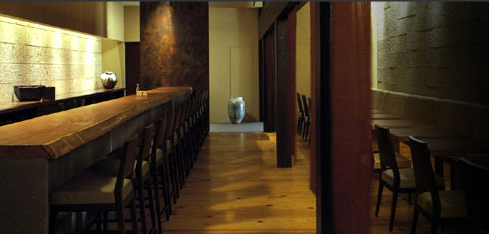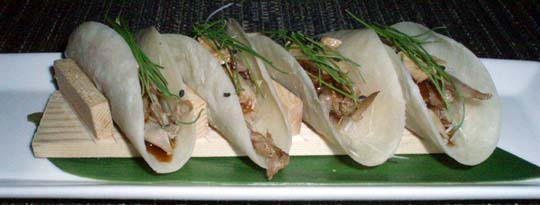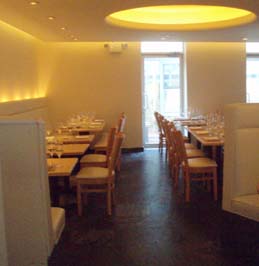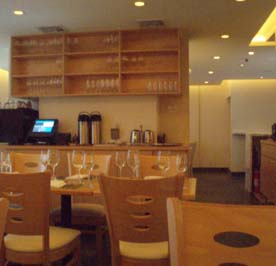Bern's Steakhouse
 Monday, May 12, 2008 at 04:41PM
Monday, May 12, 2008 at 04:41PM 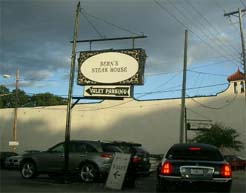
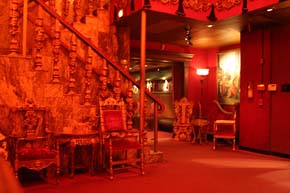
The words “fine dining” and “Tampa, Florida” seldom occur in the same sentence. For a recent family celebration, only one restaurant came to mind: Bern’s Steakhouse. It is the one Tampa restaurant with an international reputation, founded largely on its 700,000-bottle wine cellar, believed to be the largest privately-held wine collection in the world.
That collection is so large that about 80% of it is not even stored at the restaurant, but in a warehouse across the street. The 212-page novel-length wine list is a massive tome, including bottles hundreds of years old. The list of wines available by the glass (around 150) is more than most restaurants offer by the bottle.
 The restaurant, named for Bern Laxer, has been at this site since 1956. Laxer’s son, David, is now in charge.
The restaurant, named for Bern Laxer, has been at this site since 1956. Laxer’s son, David, is now in charge.
The building, not originally a restaurant, is unimpressive from the outside. But once you get in, the rest of Bern’s is as overwhelming as its wine list. Its eight dining rooms, each with a different theme, seat up to 350. Our party of eight was in a room featuring enormous photographic mural of the Rhone valley.
Bern’s doesn’t do anything small. The menu goes on for eighteen pages, several of which are long essays explaining how—in the restaurant’s favorite phrase—“We do things differently here.” Want to start with caviar? There are twenty-one selections, priced from $20–220 per ounce. Want steak tartare? Bern’s offers it four different ways.
The steak portion of the menu goes on for four pages, because Bern’s can do nothing without lecturing you. There are fifty-one ordering options—a function of the cut of meat and the desired thickness—priced anywhere from $29.10 for a six-ounce filet mignon, to $233.12 a sixty-ounce strip sirloin that feeds six. You’d think they could round the cents on a $233 steak.
Bern’s serves USDA prime beef, aged 5–8 weeks. They are aggressive about trimming fat and bone before cooking, so their eight-ounce steak has more edible content than it would at other steakhouses. The menu claims that they buy about 3–4 pounds of beef for every pound they serve.
Most of the steaks are around $35–40 per person, but Bern’s doesn’t follow the typical steakhouse à la carte model. Every entrée also includes French onion soup, a house salad, a baked potato, onion rings, and vegetables. Dinner for six adults and two children was $419 before tax and tip, and that figure included the wine—more on that below—and cocktails. The same dinner in New York would cost at least double that.

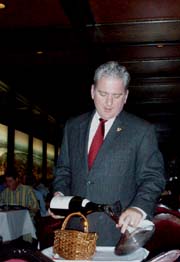
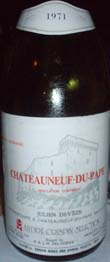
As I studied the wine list, I could hardly contain myself as I saw one bargain after another. I settled on a magnum of 1967 Julien Devèze Châteauneuf-du-Pape, which was around $140. The sommelier tried to upsell me to a bottle that was $100 more, but after I declined, he brought back the 1971, which he insisted was better, and at $126 was less expensive than the bottle I’d asked for.
To put that in perspective, at the New York wine-themed restaurant Veritas, the cheapest magnum of Châteauneuf-du-Pape costs $175, and it’s a 1999, twenty-eight years younger than the one we had. Veritas has only a handful of choices older than 1990, and only one older than 1980, whereas Bern’s has a long list of bottles going back to at least the 1960s.
The wine was superb, though I don’t have much to compare it to. In New York, a bottle that old, if you could find it, would cost the equivalent of a monthly mortgage payment.
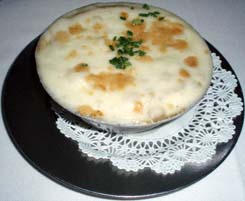
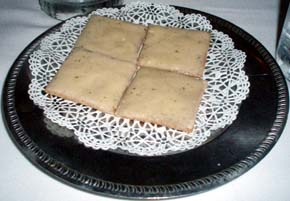
Everyone loved the French onion soup (above left), but a plate of “cheese toast” (above right)—basically melted cheese on saltine crackers—wasn’t much good at all.
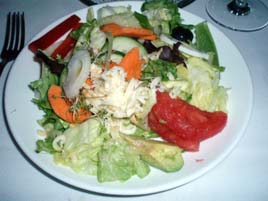

The house salad (above left) was just fine, while my son ordered the caesar salad (above right) for $9.95 extra, which our waiter prepared tableside, in a multi-step process that seemed to take fifteen minutes.
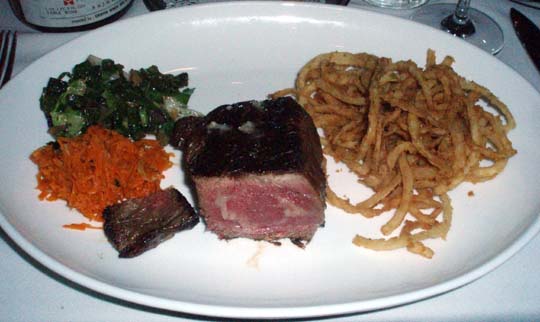
My girlfriend and I shared the 16 oz. Delmonico ($69.34), which the restaurant recommends as a portion for two. It doesn’t look that big, but we filled up quickly, given all of the other food included. The steak itself was just about perfect, with a nice exterior char, marbling, and the nutty, tangy flavor that comes from long aging.
Vegetables were a mixed bag. The onion rings were stringy and greasy, and the other vegetables on the plate were rather dull, but the baked potato was wonderful. Most restaurants would leave it to each guest to apply the fixin’s, but our waiter split each potato at tableside and applied sour cream, bacon, and chives according to each diner’s preference.
Service in the main dining room was excellent. All of Bern’s waiters train for a full year before they’re permitted to serve customers on their own. Garnishes and sauces are all applied tableside, and the waiter himself serves and clears every dish.
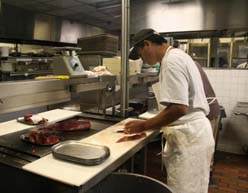
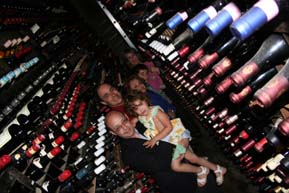
Be sure to ask for a kitchen and wine cellar tour, normally given between dinner and dessert. It takes about fifteen minutes, and is well worth it.
Dessert is such an unusual experience that you should order something even if you’re not hungry. It’s served upstairs in the Harry Waugh Dessert Room (named for a famous wine collector). It’s actually not a room, but a rabbit’s warren of many rooms: to be exact, forty-eight separate alcoves of varying sizes, each shaped like a wine cask, that can accommodate between two and twelve guests.
No one will be surprised that dessert here, like everything else, is over the top. The menu is four pages long, and has about 60 selections. It comes with yet another wine list, this one 42 pages long, with another 1,800 selections (armagnacs, cognacs, scotches, brandies, ports, etc.)
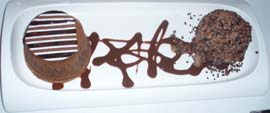
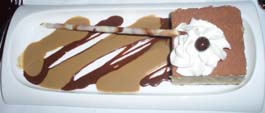
Left: Dulce de Leche Liquid Center Cake ($10.95); Right: Tiramisu ($9.95)
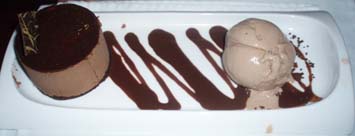
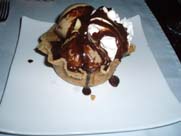
Left: Chocolate-Chocolate-Chocolate ($10.95); Right: Macadamia Nut Sundae ($10.00)
We were mildly disappointed with a Macadamia Nut Sundae, if only because its billing on the menu (“best sundae in the world”) would have been tough for any dessert to live up to. I don’t think anyone finished their desserts (how could they?) but there were vague nods of satisfaction around the table.
Service in the dessert room was nowhere near as polished as in the main dining room. The waiter’s recommendations weren’t quite as good as they were cracked up to be, and on two occasions it took a major hunting expedition to find him.
The overall dessert room bill, including drinks, was $75.60 before tax and tip.
*
After you get past the steaks, there is some unevenness at Bern’s. Any restaurant with such a long menu is bound to have some soft spots. But the overall experience is incomparable, and the wine list ranks with the great pyramids as one of the wonders of the world.
Bern’s Steakhouse (1208 South Howard Avenue, Tampa, Florida)
Food: ***
Wine & Spirits: ****
Service: ***
Ambiance: ***
Overall: ***








